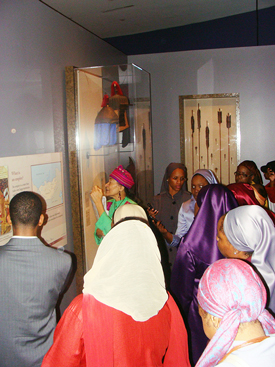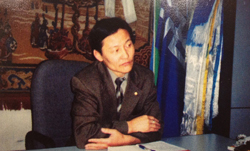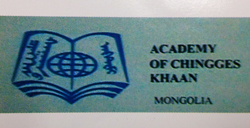Traveling the Silk Road and the Lands of Genghis Khan with the Honorable Minister Louis Farrakhan on His World Friendship Tour III
By Mother Tynnetta Muhammad | Last updated: Feb 11, 2013 - 4:15:10 PMWhat's your opinion on this article?
 “And the dwellers of the Rock indeed rejected the messengers; And We gave them Our messages, but they turned away from them; And they hewed houses in the mountains, in security. So the cry overtook them in the morning; And what they earned availed them not.” –Holy Qur’an, Surah 15, verses 80-84
“And the dwellers of the Rock indeed rejected the messengers; And We gave them Our messages, but they turned away from them; And they hewed houses in the mountains, in security. So the cry overtook them in the morning; And what they earned availed them not.” –Holy Qur’an, Surah 15, verses 80-84
Needless to say, the Honorable Minister Louis Farrakhan’s World Friendship Tours mark a pivotal turning point in the history of the Nation of Islam’s outreach to the world following the historic Million Man March held in Washington, D.C.’s capital on October 16, 1995. Within the three following years, he was guided by Almighty God, Allah, to travel abroad visiting a multitude of countries in Africa, Asia, Europe and the Middle East which also took him through parts of Central Asia or Eurasia, Russia and Siberia on the fringes of the Caucasus Mountains.

Mother Tynnetta Muhammad serves as tour guide to the Chingges Khaan Exhibit with accompanying believers in Atlanta, Georgia, on Dec. 3, 2012.
|
Never could I have imagined that as a part of his 24-member delegation that I would be so blessed to be one of only three women chosen along with his wife, Mother Khadijah Farrakhan, and Sister Karriemah Muhammad, to make this arduous journey to countries and regions of the world that I had only previously known about in the news and through visions and dreams but had never visited before. One of the great trials on this journey occurred while visiting Central Asia in the country of Dagestan on the Caspian Sea. We were the invited guests of a great Muslim revolutionary leader named Brother Ali who participated in the enormously successful Islamic Conference organized by the Honorable Minister Louis Farrakhan in Chicago, Illinois. He came to Chicago as the head of his delegation from Dagestan located on the Old Silk Road, and included a high-borne princess from the royal family of Chechnya, located near Dagestan and the Caucasus Mountains. There we were in the cold winter being received in great honor as our private plane landed on the tarmac by Dagestan citizens who performed, dressed in their elegant apparel with swords flashing in the dead of night to receive the Honorable Minister Farrakhan and his delegation.
It was so cold in that city and region on the shores of the Caspian Sea that we slept in the guest hotel with our boots on wrapped in our fur-lined coats with blankets piled on top to keep warm. When opening the curtains the next morning, the sun was shining brightly on a bleak portion of the seashore where waves whipped and tumbled fiercely across a narrow concrete bridge within our view. While at dinner with our host family, I asked about the ethnic origins of the people in that area. I was told that the population was mixed with Mongol blood through the conquests of Genghis Khan’s army. When arriving in the Russian capital of Moscow to attend the Eid Feast of Ramadan in 1997 where Minister Farrakhan was invited as a guest speaker, I was further told by the driver of our van, as we were approaching the Grand Mosque, that the people gathered there were Tatar Muslims. This meant that once again the conquering armies of Genghis Khan and his Golden Family had made inroads into the Russian population, Siberia, the Ural Mountains, parts of the Himalayas, as well as the Caucasus Mountains. I often wondered throughout my studies if this co-mingling of the bloodline of Tatar (Mongolian) and Turkish ancestry in these regions might in some way have a connection to the tribal family on the Mahdi’s mother’s side. Certainly the unusual linguistic dialects connected to the Mahdi’s parents’ names indicate the possibility of an Indeo-European origin which includes linguistic roots linked to Urdu, Persian, Arabic and combinations thereof.
In the names Bebi-G or Baba-G, often pronounced Baby-G, his mother’s name, and Alphonso, his father’s name, can be traced to a Latinized Arabic origin adopted to the Spanish language including Portugese. This mixture of the languages with Arabic roots occurred during the period of the Moors’ occupation of Spain for 800 years who ruled with highly developed sciences that inspired the Renaissance. This Spanish-Arabic culture was later carried into the Western Hemisphere by Portugese and Spanish conquerors and has left its mark in Mexico, Central and South America with its language and culture.
I wondered if through my studies I had touched upon the basis of what the Most Honorable Elijah Muhammad had shared with me and others about his desire to send some students to study music in North Africa, in addition to asking me to consider the study of people and culture of the Spanish Sahara, which is geographically connected to Mauritania, Morocco, Tunisia, Mali and Timbuktu, the origin of Moorish civilization. Was he possibly giving me a hint pointing to the people of origin on the Mahdi’s father’s side as an original Black man? The Most Honorable Elijah Muhammad shared with us that some of the Believers would be blessed one day to be invited to attend a special dinner hosted by the mother of the Great Mahdi, Himself. Our travels to Central Asia and Africa, including Mali and Timbuktu, in the company of the Honorable Minister Louis Farrakhan, takes us to the peripheral of the lands representing possible places of his parents’ origin.

President and Founder of The Academy of Genghis Khan, Mr. Purev-Oidovyn Davaanyam.
|
As we continued being the guests of family members in dinner settings throughout our World Friendship Tour III, both in Daghestan and Siberia in the Caucasus Mountains region and in Africa, represented a sign of events to take place in our lifetime and that of generations to come. Indeed, we were traveling along the Silk Road entering lands conquered by Genghis Khan and his Golden Family, which may connect to our own Nation’s future development. Dr. P. Davaanyam, President of the Chingges Khaan Academy in Ulaanbaatar, Mongolia, 29th Descendent of Genghis Khan, certainly thinks so, and is open to the profound thought that we of the Lost-Found Nation of Islam in the West, could represent a sign of the Return of Genghis Khan and his Golden Family.
Mr. Davaanyam writes in his book on the subject of “The Return of Genghis Khan,” the following words under the subtitle, “Mongolian Khan thought: Philosophy Fit For A King,” Purev-Oidovyn Davaanyam believes in the power of philosophy.

|
“And certainly We have given thee seven oft-repeated (verses) and the grand Qur’an.”–Holy Qur’an, Surah 15, verse 87
To be continued.
INSIDE STORIES AND REVIEWS
-
-
About Harriett ... and the Negro Hollywood Road Show
By Rabiah Muhammad, Guest Columnist » Full Story -
Skepticism greets Jay-Z, NFL talk of inspiring change
By Bryan 18X Crawford and Richard B. Muhammad The Final Call Newspaper @TheFinalCall » Full Story -
The painful problem of Black girls and suicide
By Charlene Muhammad -National Correspondent- » Full Story -
Exploitation of Innocence - Report: Perceptions, policies hurting Black girls
By Charlene Muhammad -National Correspondent- » Full Story -
Big Ballin: Big ideas fuel a father’s Big Baller Brand and brash business sense
By Bryan Crawford -Contributing Writer- » Full Story






 Click Here Stay Connected!
Click Here Stay Connected!








